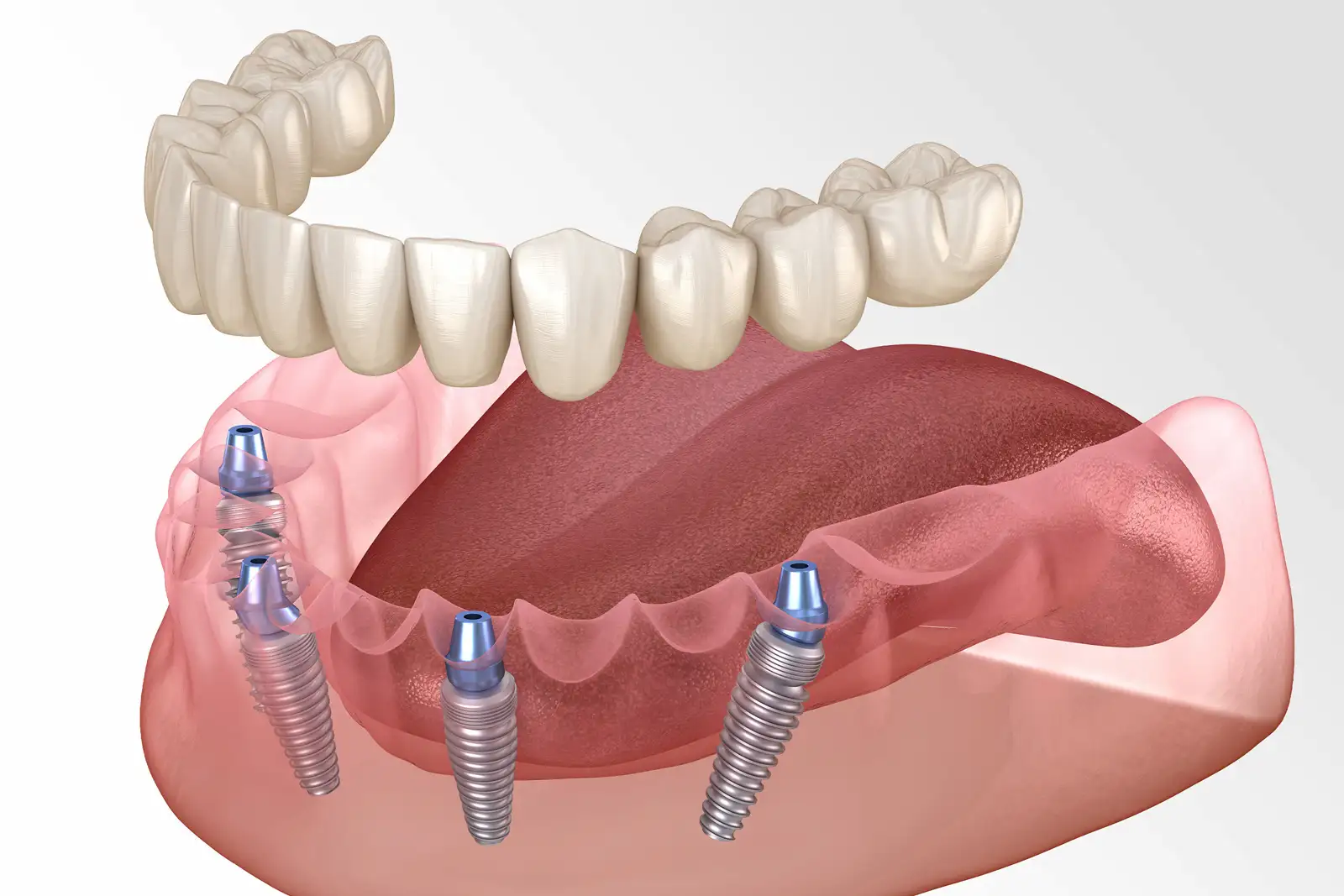All-on-4
The All-on-4 technique is a modern dental solution for individuals seeking a permanent replacement for all teeth in one jaw with a minimal number of implants, completed in the shortest possible time.

Precisely placed implants provide a stable and functional fixed prosthesis, offering excellent aesthetics and preserving the jawbone.
What is All-on-4?
The All-on-4 dental method enables the complete reconstruction of all teeth in one jaw by placing just four dental implants that support a fixed prosthesis.
The two front implants are placed vertically, while the two back implants are positioned at an angle. This specific arrangement ensures optimal distribution of chewing forces and maximum prosthesis stability.
There is no need for additional procedures such as bone grafting or sinus lifts, and a temporary fixed prosthesis can often be placed on the same day as the implants.
All-on-4 is a fixed, long-term solution for complete tooth loss, providing patients with a natural appearance and full dental function.
Advantages of the All-on-4 Method
- Fast and efficient – implants and a temporary prosthesis placed in a single day
- Permanent stability – the prosthesis is fixed and will not shift
- Natural, aesthetic appearance – the prosthesis is customized to match the shape of the face and jaw
- No need for bone grafting – implants are strategically placed to avoid complex bone augmentation or sinus lift surgeries
- Long-lasting – with proper care and regular check-ups, implants can serve as a lifelong solution
Who are candidates for All-on-4?
The All-on-4 method is ideal for patients who:
- Are completely edentulous in one or both jaws
- Have severely damaged teeth due to periodontitis or decay
- Have worn removable dentures for years and seek a fixed solution
- Have reduced bone volume and want to avoid complicated bone grafting procedures
- Want a fast and permanent restoration of dental aesthetics and function
To successfully place implants, patients must have sufficient remaining bone in the front part of the jaw and be in stable general health.
The All-on-4 procedure
The procedure can be completed in one day or over several visits, depending on the patient’s individual needs. The standard process includes:
1. First visit – Diagnosis and treatment planning
- Comprehensive dental examination and oral health assessment
- 3D CBCT scan of the jaw to evaluate bone quantity and quality
- Planning the optimal implant placement and type of prosthesis
2. Second visit – Surgical implant placement
- Removal of any remaining damaged teeth (if necessary)
- Placement of four implants under local anesthesia or sedation
- Minor bone modifications if needed to ensure implant stability
- Placement of a temporary fixed prosthesis on the same day (in most cases)
Healing and osseointegration period (3–6 months)
- During healing, the implants fuse with the bone, and the patient wears a temporary prosthesis while following dietary and hygiene recommendations
3. Third visit – Fabrication and placement of the final prosthesis
- Once osseointegration is complete, precise impressions are taken
- A permanent prosthesis is fabricated from high-quality materials such as zirconia or composite resin
- The final prosthesis is securely attached to the implants, with final adjustments made for optimal comfort and appearance
With proper care and regular dental visits, All-on-4 remains one of the best modern solutions for complete tooth loss.
This method provides patients with a fast, safe, and aesthetically appealing dental solution without the need for more invasive surgical procedures.
Frequently asked questions about All-on-4
In most cases, patients receive a temporary prosthesis on the same day the implants are placed. The permanent prosthesis is fitted 3–6 months later, after the implants have fully integrated with the jawbone.
No, the procedure is performed under local anesthesia or sedation, so patients do not feel pain. Mild discomfort afterward can be managed with pain relievers.
Most patients recover quickly, often within just a few days, with minimal complications. Mild swelling and discomfort may occur in the first few days.
With proper care, dental implants can last a lifetime. The prosthesis itself may need replacement after 10–15 years, depending on wear and tear.
Yes, the prosthesis is designed to look and function like natural teeth, and patients can choose the color, shape, and size of the teeth.
Very soon after the procedure, you will be able to eat most foods, though extremely hard foods should be avoided initially.
Regular brushing, the use of interdental brushes, and routine dental check-ups are essential to maintain the longevity of the implants.
The cost varies depending on the materials used and the complexity of the procedure. A consultation with a dentist is recommended to get an accurate price estimate.
The All-on-4 technique is specifically designed to avoid the need for bone grafting, but in rare cases, additional procedures may be necessary.
In rare cases, an implant may fail to integrate, but it can usually be removed and replaced. Smoking and poor oral hygiene significantly increase the risk of implant failure.
Contact us
Our friendly team will be happy to listen to your requests.
